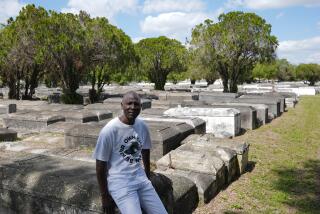Mayor pledges to put cemetery back in its town
- Share via
For generations, the folk of East Bangor — one main street, no stoplights — have buried their dearly departed in 11 grassy acres on the edge of town, carving simple headstones from slate, the lifeblood of the region.
When the time came, many bought plots of their own in the small cemetery. Most went to their graves believing they’d spend their eternal slumber in their hometown — after all, the sign at the entrance said “East Bangor Cemetery.”
Well, not quite.
The cemetery is actually in neighboring Upper Mount Bethel Township, and has been since the land was bought in 1890 for $839.50. Though the graveyard sits at the eastern edge of East Bangor, through some trick of surveying, not a single spoonful of cemetery dirt belongs to the Pennsylvania town that shares its name.
Most of the borough’s 1,100 residents never realized this. Indeed, many members of the cemetery’s own board of directors didn’t know it was outside the borough proper, or assumed at least part of it lay within town limits.
So imagine their surprise when East Bangor Mayor Gaylord Weidlick broke the news when he was elected in 2009 — and told them he wanted to bring the cemetery home.
“When I became mayor, I decided to make that a goal,” said Weidlick, who is also the cemetery board’s president. “I was going to get East Bangor Cemetery officially moved.”
Weidlick is what you’d expect in a small-town mayor: retired, stubborn and fiercely proud of his hometown, which lies near the New Jersey border and musters nostalgia for the good old days. He calls it Mayberry, a reference to the glorified North Carolina town of yore in the “The Andy Griffith Show.”
Weidlick never left East Bangor, the bounds of his universe marked by the country restaurant at one end of town and the comparatively cosmopolitan Bangor (population 5,273) at the other. As a youngster, he marched with the Boy Scouts into the cemetery every Memorial Day and saluted the flag. It was a thrill: “Not a lot to do in Mayberry,” he says with a chuckle.
Since retiring from the power company Metropolitan Edison, he’s taken responsibility for the cemetery’s upkeep, a volunteer gig that’s grown into a full-time job. He and his wife, Betty Jane, stop in at the cemetery at least once a day, sometimes working six or seven hours mowing grass, cleaning up gravestones and filling in sinkholes.
One recent afternoon, the mayor trundled around on his tractor, attaching plastic ties to flags marking veterans’ graves to make sure they don’t come undone. He takes almost an obsessive pride in maintaining the graveyard, whose headstones shine with the curt names of minor Slate Belt royalty.
Built around a central quadrangle, the cemetery houses 3,600 souls, including 300 veterans, the oldest being T.H. Parsons, who died in 1918 in France. It also hosts the remains of Laura Snik, who died in the Sept. 11 terrorist attacks, and Weidlick’s childhood friend Leslie Couch, a casualty of the Vietnam War.
There’s plenty of room for more, according to the maps stapled to the walls of Weidlick’s makeshift office in the cemetery’s tool shed. And thanks to his efforts, the graveyard is better maintained than most of its ilk, small and unattached to a church congregation.
But the question must be asked: Why bother with the switch? What’s the difference to the dead? Or even to the mayor, who admits he’ll be buried a few miles away in Plainfield Township?
It’s about East Bangor, he said. It’s about a stubborn town that still runs its own water company, resisted giving up its high school and sure as heck won’t hand over its cemetery.
“It’s about pride,” he said. “A lot of people from East Bangor are buried here, and they’re not in East Bangor, technically.”
At Weidlick’s urging, and after a more than a year of unraveling bureaucratic red tape, East Bangor and Upper Mount Bethel filed a joint petition asking a county judge to extend East Bangor’s town limits to include the cemetery.
The judge recently agreed, and the deceased residents of East Bangor now truly, officially and — one might hope — peacefully rest in East Bangor.
More to Read
Sign up for Essential California
The most important California stories and recommendations in your inbox every morning.
You may occasionally receive promotional content from the Los Angeles Times.











